1972–73 Australian region cyclone season
| 1972–73 Australian region cyclone season | |
|---|---|
 Season summary map | |
| Seasonal boundaries | |
| First system formed | 7 December 1972 |
| Last system dissipated | 6 May 1973 |
| Strongest storm | |
| Name | Unnamed |
| • Maximum winds |
165 km/h (105 mph) (10-minute sustained) |
| • Lowest pressure | 950 hPa (mbar) |
| Seasonal statistics | |
| Tropical lows | 15 |
| Tropical cyclones | 15 |
| Severe tropical cyclones | 8 |
| Total fatalities | 1,574+ |
| Total damage | Unknown |
| Related articles | |
The 1972–73 Australian region cyclone season was an above average tropical cyclone season.
Systems
Tropical Cyclone Ivy-Beatrice
| Category 1 tropical cyclone (Australian scale) | |
| Tropical storm (SSHWS) | |
  | |
| Duration | December 7 – December 9 (Crossed 80°E) |
|---|---|
| Peak intensity | 65 km/h (40 mph) (10-min) 994 hPa (mbar) |
Tropical Cyclone Ivy developed over the eastern Indian Ocean on December 7. The cyclone entered the southwest Indian Ocean basin after crossing 80°E and was renamed Beatrice.
Severe Tropical Cyclone Jean
| Category 4 severe tropical cyclone (Australian scale) | |
| Category 1 tropical cyclone (SSHWS) | |
  | |
| Duration | January 10 – January 17 |
|---|---|
| Peak intensity | 160 km/h (100 mph) (10-min) 964 hPa (mbar) |
On January 10, Jean developed northwest of Western Australia. It strengthened into a Category 4 severe tropical cyclone, before being last noted on January 17.
Severe Tropical Cyclone Kerry
| Category 4 severe tropical cyclone (Australian scale) | |
| Category 2 tropical cyclone (SSHWS) | |
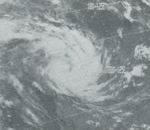  | |
| Duration | January 19 – January 24 |
|---|---|
| Peak intensity | 185 km/h (115 mph) (10-min) 960 hPa (mbar) |
At Wickham on 21 January 1973 more than 30 houses were partly unroofed and some houses received major damage. There was no damage to buildings in Dampier, Roebourne or Karratha as the cyclone crossed the coast well to the east. Kerry passed close to a number of oil-drilling rigs causing damage and lost productivity time that cost over one million dollars. Maximum recorded gust was 140 km/h at Cape Lambert.[1]
Tropical Cyclone Leila-Gertrude
| Category 2 tropical cyclone (Australian scale) | |
| Tropical storm (SSHWS) | |
 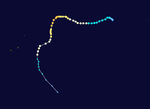 | |
| Duration | January 21 – January 23 (Crossed 80°E) |
|---|---|
| Peak intensity | 100 km/h (60 mph) (10-min) 980 hPa (mbar) |
Tropical Cyclone Leila formed offshore Western Australia on January 21. Moving generally westward, the storm crossed 80°E on January 23 and was renamed Gertrude.
Severe Tropical Cyclone Adeline
| Category 3 severe tropical cyclone (Australian scale) | |
| Category 1 tropical cyclone (SSHWS) | |
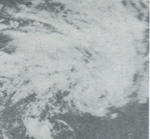  | |
| Duration | January 27 – January 29 |
|---|---|
| Peak intensity | 120 km/h (75 mph) (10-min) 970 hPa (mbar) |
Tropical Cyclone Adeline developed in the Gulf of Carpentaria on January 27. Moving south-southwestward, Adeline made landfall near the Northern Territory-Queensland border, shortly before dissipating on January 29.
Tropical Cyclone Maude
| Category 2 tropical cyclone (Australian scale) | |
| Tropical storm (SSHWS) | |
  | |
| Duration | January 28 – January 31 |
|---|---|
| Peak intensity | 95 km/h (60 mph) (10-min) 990 hPa (mbar) |
Tropical Cyclone Maude existed offshore Western Australia from January 28 to January 31.
Tropical Cyclone Kristy
| Category 2 tropical cyclone (Australian scale) | |
| Category 1 tropical cyclone (SSHWS) | |
 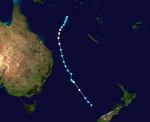 | |
| Duration | February 24 – March 1 |
|---|---|
| Peak intensity | 115 km/h (70 mph) (10-min) 975 hPa (mbar) |
Tropical Cyclone Kristy developed southwest of the Solomon Islands on February 24. Heading generally southward, Kristy dissipated well east of New South Wales on March 1.
Severe Tropical Cyclone Leah
| Category 3 severe tropical cyclone (Australian scale) | |
| Category 1 tropical cyclone (SSHWS) | |
  | |
| Duration | February 27 – March 11 |
|---|---|
| Peak intensity | 130 km/h (80 mph) (10-min) 973 hPa (mbar) |
The next system, Cyclone Leah, formed near the coast of Western Australia on February 27. Moving southwestward, Leah eventually dissipated on March 11.
Severe Tropical Cyclone Madge
| Category 3 severe tropical cyclone (Australian scale) | |
| Category 2 tropical cyclone (SSHWS) | |
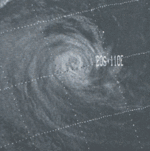  | |
| Duration | February 28 – March 18 |
|---|---|
| Peak intensity | 140 km/h (85 mph) (10-min) 952 hPa (mbar) |
Cyclone Madge originated in the vicinity of the Solomon Islands on February 28. Tracking west-southwestward, Madge struck the Cape York Peninsula early on March 4. By late the following day, the cyclone made landfall near Numbulwar, Northern Territory. Moving across Northern Territory and Queensland, Madge emerged into the Indian Ocean on March 10. The storm headed generally westward for the next several days, until dissipating on March 18.
Severe Tropical Cyclone Nellie
| Category 3 severe tropical cyclone (Australian scale) | |
| Category 1 tropical cyclone (SSHWS) | |
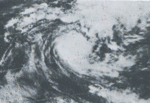  | |
| Duration | March 13 – March 23 |
|---|---|
| Peak intensity | 130 km/h (80 mph) (10-min) 964 hPa (mbar) |
On March 13, Cyclone Nellie formed offshore Queensland. It moved generally west-southwestward before dissipated on March 23.
Tropical Cyclone Bella
| Category 1 tropical cyclone (Australian scale) | |
| Tropical storm (SSHWS) | |
  | |
| Duration | March 20 – March 25 |
|---|---|
| Peak intensity | 65 km/h (40 mph) (10-min) 998 hPa (mbar) |
Cyclone Bella developed over the Arafura Sea on March 20. It struck North Territory before dissipating on March 25.
Tropical Cyclone Paula
| Category 1 tropical cyclone (Australian scale) | |
| Tropical storm (SSHWS) | |
  | |
| Duration | March 26 – April 1 |
|---|---|
| Peak intensity | 75 km/h (45 mph) (10-min) 997 hPa (mbar) |
The next system, Cyclone Paula, formed southwest of Indonesia on March 26. Paula moved southwestward and dissipated about six days later.
Tropical Cyclone Roma
| Category 2 tropical cyclone (Australian scale) | |
| Tropical storm (SSHWS) | |
  | |
| Duration | April 18 – April 23 |
|---|---|
| Peak intensity | 100 km/h (60 mph) (10-min) 982 hPa (mbar) |
Cyclone Roma existed from April 18 to April 23.
Unnamed Severe Tropical Cyclone
| Category 3 severe tropical cyclone (Australian scale) | |
| Category 3 tropical cyclone (SSHWS) | |
  | |
| Duration | April 26 – April 29 |
|---|---|
| Peak intensity | 150 km/h (95 mph) (10-min) 950 hPa (mbar) |
The strongest tropical cyclone of the season, also nicknamed "Cyclone Flores", developed in the Banda Sea on April 26. The storm peaked with a barometric pressure of 950 mbar (28 inHg). The storm struck the island of Flores before dissipating on April 29. Widespread destruction of houses, schools, and bridges was reported in four of the island's districts. 53 on Flores were killed, and 21 perished in the sinking of a Timorese fishing ship, the Oarbiru.[2] Additionally, over 1,500 fishermen were reported lost at sea. The area's remoteness kept information about the cyclone's effects from reaching the news for over a month.[3]
Severe Tropical Cyclone Marcelle
| Category 4 severe tropical cyclone (Australian scale) | |
| Category 1 tropical cyclone (SSHWS) | |
 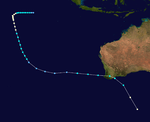 | |
| Duration | April 29 – May 9 |
|---|---|
| Peak intensity | 160 km/h (100 mph) (10-min) 973 hPa (mbar) |
Marcelle, the final tropical cyclone of the season, developed well west of Indonesia on April 29. The storm struck near Busselton, Western Australia late on May 7. Marcelle dissipated well south of Australia about two days later.